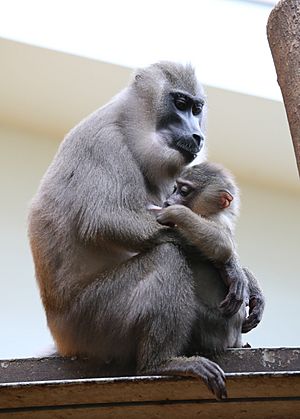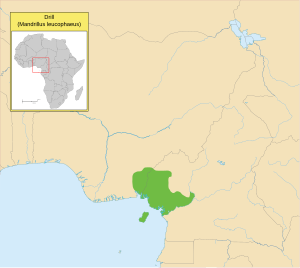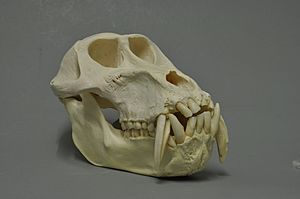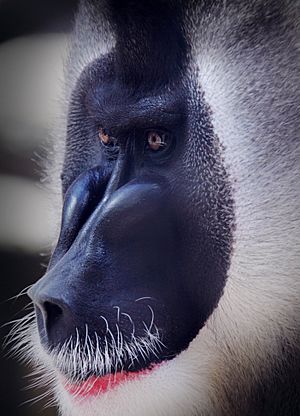Drill (animal) facts for kids
Quick facts for kids Drill |
|
|---|---|
 |
|
| Male at Limbe Wildlife Centre, Cameroon | |
 |
|
| Female with infant at Tierpark Hellabrunn in Munich, Germany | |
| Conservation status | |
| Scientific classification | |
| Genus: |
Mandrillus
|
| Species: |
leucophaeus
|
| Subspecies | |
|
M. l. leucophaeus |
|
 |
|
| Drill range | |
The drill (Mandrillus leucophaeus) is a type of primate. It belongs to the Cercopithecidae family, which includes "Old World monkeys." Drills are related to baboons. They are even more closely related to mandrills.
Contents
What Does a Drill Look Like?
Drills are monkeys with short tails. They can grow up to 70 cm (28 in) long. They look a lot like mandrills. However, drills do not have the bright blue and red faces that mandrills do.
Male and female drills are different sizes. This is called sexual dimorphism. Males can weigh up to 20 kg (44 lb). Females are smaller, weighing up to 12.5 kg (28 lb).
Their bodies are mostly dark grey-brown. Adult male drills have a pink lower lip and a white chin. Their faces are dark grey to black. They also have raised grooves on their noses. The skin on their rear end can be pink, mauve, and blue. Female drills do not have the pink chin.
Where Do Drills Live?
Drills are found in specific parts of Africa. They live in rainforests. You can find them in Cross River State in Nigeria. They also live in southwestern Cameroon. Their habitat goes south to the Sanaga River. Drills also live on Bioko Island. This island is part of Equatorial Guinea.
Their total living area is quite small. It is less than 40,000 square kilometers.
Drill Family and Habits
A strong male drill leads a group. These groups have many males and females. They usually have 20 to 30 individuals. The dominant male is the father of most young drills. Sometimes, several groups join together. They can form "super groups" with over 100 drills.
Drills move around during different seasons. They often rub their chests on trees. This helps them mark their territory. They spend a lot of time on the ground looking for food. But they climb trees to sleep safely at night.
Female drills usually have one baby at a time. Twins have been seen only once. This happened at a special center in Nigeria. Drills can live for about 28 years in zoos.
What Do Drills Eat?
Drills mostly eat fruit. This means they are frugivorous. They enjoy many different kinds of fruit. But they also eat other things. Their diet includes herbs and roots. Sometimes, they eat eggs, insects, and small mammals.
Why Are Drills Endangered?
Drills are one of Africa's most endangered mammals. The IUCN lists them as a top priority for protection. Their numbers have been dropping for many years. This is due to several reasons.
One big reason is hunting. People hunt drills illegally for their meat. Another problem is habitat destruction. Their rainforest homes are being cut down. Human development also takes away their land.
There might be as few as 3,000 drills left in the wild. Some estimates say up to 8,000. Many drills are being helped. About 174 drills rescued from illegal capture live at a center in Nigeria. This center helps them breed successfully. Around 40 drills live in zoos around the world.
See also
 In Spanish: Dril para niños
In Spanish: Dril para niños





